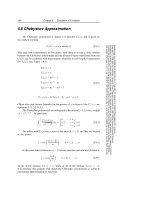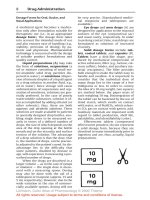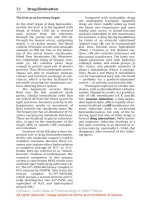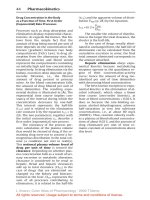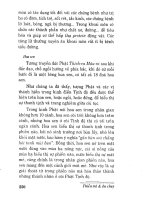AN ATLAS OF DEPRESSION - PART 9 doc
Bạn đang xem bản rút gọn của tài liệu. Xem và tải ngay bản đầy đủ của tài liệu tại đây (1.02 MB, 11 trang )
No
depression
Progression
to disorder
Symptoms
Syndrome
Severity
Treatment phases
Time
Recurrence
Remission
Acute Continuation Maintainance
Full
recovery
Relapse
Relapse
R
e
sp
o
n
se
Figure 7.20 Single-photon emission computed tomography
scans (red and green scales) in the sagittal plane of a normal
individual (top) and an 88-year-old man with clinical depression
(middle and bottom).Circled areas represent reduced perfusion
to the frontotemporal cortex. Printed with permission
from the Department of Radiology, Brigham and
Women’s Hospital, Boston, MA, USA. -
vard.edu/education/online/BrainSPECT/
Figure 8.1 Treatment phases in depression.Adapted with permission from Kupfer DJ. Long-term treatment of depression. J Clin
Psychiatry 1991;52 (suppl):28–34
©2002 CRC Press LLC
1.0
0.9
0.8
0.7
0.6
0.5
0
1 2 3 4 5 6 7 8 9 10 11 12
Probability of remainin
g
Number of weeks following transfer to placeb
o
Fluoxetine
Placebo
1.0
0.9
0.8
0.7
0.6
0.5
0
1 2 3 4 5 6 7 8 9 10 11 12
Probability of remainin
g
Number of weeks following transfer to placebo
Fluoxetine
Placebo
70
60
50
40
30
20
10
SSRI (n=6150) TCA (n=10 054)
0
%
Recommended
Insufficient length
Inadequate dose
Insufficient and inadequate
200
250
150
100
50
0
Days of treatment
Fluoxetine
(n=945)
Paroxetine
(n=492)
Sertraline
(n=905)
*
* p < 0.00
The ideal
antidepressant
Effective in
short-term and
long-term
treatments
Effective
across range
of depressive
disorders
Safe in
overdose
Free from
interactions
with food or
drugs
Suitable in
physically ill
No
behavioral
toxicity
Well-tolerated
Cost-effective
Once-daily
dosage
Rapid
onset of
action
Effective
across range
of age
groups
Tolerability
and safety
Efficacy
Figure 8.2 Continuation treatment of depression over 3
months. Survival analysis comparing treatment with fluoxetine
and placebo during treatment weeks 12 and 24.After 3 months
of open-label treatment, continuing with fluoxetine prevents
relapse of depressive symptoms in the next 3 months.Adapted
with permission from Reimherr FW,Amsterdam HD, Quitkin
FM, et al. Optimal length of continuation therapy in depression: a
prospective assessment during long-term treatment with fluox-
etine. Am J Psychiatry 1998;155:1247–53
Figure 8.3 Continuation treatment of depression after 6
months. Survival analysis comparing treatment with fluoxetine
and placebo during treatment weeks 26 and 38.After 6 months
of treatment, continuing with fluoxetine prevents relapse of
depressive symptoms in the next 3 months.Adapted with per-
mission from Reimherr FW,Amsterdam HD, Quitkin FM, et al.
Optimal length of continuation therapy in depression: a prospec-
tive assessment during long-term treatment with fluoxetine. Am
J Psychiatry 1998;155:1247–53
Figure 8.4 Dosage and duration of antidepressant drugs.
Adapted with permission from Dunn RL, Donoghue JM,
Ozminkowski RJ, et al. Longitudinal patterns of antidepressant
prescribing in primary care in the UK: comparison with treat-
ment guidelines. J Psychopharmacol 1999;13:136–43. © British
Association for Psychopharmacology, 1999)
Figure 8.5 Duration of SSRI treatment.Adapted with permis-
sion from Russell JM, Berndt ER, Miceli R, Colucci S, Grudzinski
AN. Course and cost of treatment for depression with fluoxe-
tine, paroxetine, and sertraline. Am J Manag Care 1999;5:597–606
Figure 9.1 The ideal antidepressant
©2002 CRC Press LLC
Establish the presence of a depressive disorder
Exclude underlying severe mental disorder
(e.g. schizophrenia)
Refer to psychiatric services
Review the
patient later
Start
antidepressant
Psychosis Severe MildModerate
Establish whether physical illness present
Choose an effective, well tolerated, safe antidepressant
Warn the patient about possible side effects
Prescribe at low dose for 1–2 days, then increase to an effective dose
Review adherence and side effects within 1 week
Evaluate efficacy at around 4 weeks
Determine the severity of depression
100 80 60 40 20 0 20 40 60 100 300 500
More serotonin selective
More norepinephrine select
ive
imipramine
amitriptyline
amoxapine
protriptyline
nortriptyline
desipramine
maprotiline
venlafaxine
norepinephrine uptake K
i / serotonin Ki
serotonin K
i / norepinephrine up
take K
j
fluoxetine
paroxetine
sertraline
fluvoxamine
0
20
40
60
80
100
Older tricyclic antidepressants
Lofepramine
Selective serotonin reuptake inhibitors
Percentage of prescribed subtherapeutic doses
Donoghue, Tylee A (1996)
Data sources 1, 2 and 3
MacDonald TM et al (1996)
Donoghue JM et al (1996)
N
N
CH
2
CH
2
CH
2
CH
3
CH
3
Cl
Figure 9.2 Criteria for starting patients on antidepressants
Figure 9.3 Spectrum of action of selected antidepressants
Figure 9.4 Primary care prescribing of antidepressants
Figure 9.5 Molecular structure of clomipramine, an example
of a tricyclic antidepressant
©2002 CRC Press LLC
Consequences of
muscarinic
receptor blockade
Blurred vision
Glaucoma
Dry mouth
Tachycardia
Urinary retention
Constipation
Consequences of
a
1
-adrenoceptor
blockade
Confusion
Consequences of
H
1
-receptor blockade
Sedation
Dizziness
Other effects
Weight gain
Sedation
Reduced sexual
function
Cardiotoxicity
(from cardiac
conduction block
with quinidine-like
effect)
Orthostatic
hypotension
Phenelzine
H
CH
2
CH
2
NH
2
N
Pargyline
CH
2
N
C
H
3
CH
2
C
CH
Isocarboxazid
N
H
H
CH
2
O
N
CH
3
O
C
N
Figure 9.7 Typical side-effects of the tricyclic antidepressants
Figure 9.8 Molecular structures of typical non-selective
MAOIs (phenelzine, pargyline and isocarboxazid)
NE terminal
Norepinephrine (NE) receptor
(b
1
, b
2
, a
1
etc.)
Serotonin receptor
(5-HT
1A
, 5-HT
2
etc.)
TCAs
act at
uptake site
TCAs
act at
uptake site
5-HT terminal
Figure 9.6 Tricyclic antidepressant (TCA) mode of action.TCAs inhibit the reuptake of serotonin and norepinephrine into presynap-
tic neurones.Additional effects at other receptors (e.g. anticholinergic effects) are largely responsible for adverse effects
©2002 CRC Press LLC
Norepinephrine or
5-HT receptor
MAO
Hypertensive crisis
(following ingestion
of tyramine-rich food)
Flushing
Headache
Increased cholinergic
transmission in the
sympathetic ganglia leads
to orthostatic hypotension
Increased serotonin
transmission in the brain
stem leads to insomnia
Increased serotonergic
transmission in the
mesolimbic system and in
spinal neurons leads to
sexual dysfunction
N
O
CH
2
CH
2
Cl
HO
C N
Agitation
Anxiety
Excitability
Dizziness
Sleep disturbances
Tyramine pressor response
(flushing, headache, increased
blood pressure) following
ingestion of tyramine-rich
foodstuffs
Nausea
Figure 9.9 MAOI mode of action. MAOI antidepressants
inhibit the breakdown of norepinephrine and serotonin, and
increase their availability at postsynaptic receptors
Figure 9.10 The reported side-effects of MAOIs
Figure 9.11 The molecular structure of the reversible selective
monoamine oxidase inhibitor (MAOI) moclobemide
Figure 9.12 The reported side-effects of selective MAOIs
©2002 CRC Press LLC
Fluvoxamine
Fluoxetine
Citalopram
CH
2
CH
2
CH
2
CH
2
OCH
3
CH
2
CH
2
NH
2
Sertraline
Paroxetine
Cl
O
N
CF
3
CF
3
H
H
H
H
Cl
Cl
CH
3
O
N
CH
2
CH
2
CH
3
H
CH
CH
2
O
O
NH
O
F
N
N
CH
2
F
CH
2
CH
3
C
O
CH
2
CH
3
Figure 9.13 Molecular structures for various SSRIs
©2002 CRC Press LLC
5-HT receptor
(5-HT
2A
, 5-HT
2C
, 5-HT
1A
, etc.)
5-HT
uptake
site
5-HT terminal
Headache
Agitation
Akathisia
Parkinsonism
Sedation
Dizziness
Convulsions
Sexual dysfunction
Nausea
Vomiting
Diarrhea
80
70
60
50
40
30
20
10
Emergence Worsening Improvement
0
Placebo (n=569)
Fluoxetine (n=1765)
TCA (n=731)
0.09
0.08
0.07
0.06
0.05
0.04
0.03
0.02
0.01
Suicide Suicide attempts
0
Placebo (n = 554)
Paroxetine (n = 2963)
Controls (n = 1151)
Figure 9.14 SSRI mode of action. SSRIs inhibit reuptake of 5-
HT into presynaptic neurones. Increased availability at 5-HT
1A
receptors is probably responsible for antidepressant efficacy.
Actions at other receptors may result in adverse effects: anxiety,
insomnia and sexual dysfunction (5-HT
2
), and nausea and vomit-
ing (5-HT
3
)
Figure 9.15 SSRI side-effects
Figure 9.16 SSRIs are not associated with a worsening of sui-
cidal thoughts, as shown by this pooled analysis of 17 random-
ized controlled trials using suicide item of HAM-D.Adapted with
permission from Beasley CM, Dornseif BE, Bosomworth JC, et
al. Fluoxetine and suicide: a meta-analysis of controlled trials of
treatment for depression. Br Med J 1991;303:685–92
Figure 9.17 A pooled analysis of randomized controlled trials
of paroxetine showing it is not associated with an increase in
suicidal behavior. Adapted from Eur Neuropsychopharmacol
1995;5:5–13. Montgomery SA, Dunner DL, Dunbar GC.
Reduction of suicidal thoughts with paroxetine in comparison
with reference antidepressants and placebo. PEY, patient-expo-
sure years. Copyright 1995, with permission from Elsevier
Science
©2002 CRC Press LLC
NE terminal
Norepinephrine (NE) receptor
(b
1
, b
2
, a
1
etc.)
Serotonin receptor
(5-HT
1A
, 5-HT
2
etc.)
SNRIs
act at
uptake site
SNRIs
act at
uptake site
5-HT terminal
Dry mouth
In high doses
Dizziness
Sleep disturbances
Headache
Agitation
Insomnia
Nausea
Central nervous
system depression
Seizures
Cardiovascular effects
Hypertension
Headache
Nausea
Dizziness
Discontinuation
effects
Figure 9.18 Molecular structures of SNRIs venlafaxine and mil-
nacipran
Figure 9.19 SNRI mode of action. SNRIs increase availability of both serotonin and norepinephrine without unwanted interactions at
postsynaptic receptors
©2002 CRC Press LLC
Viloxazine
OC
2
H
5
O
N
H
O
CH
2
Reboxetine
OC
2
H
5
O
HC
H
O
N
H
NE terminal
Norepinephrine (NE) receptor
(b
1
, b
2
, a
1
etc.)
NE
uptake
site
Constipation
Dry mouth
Increased sweating
Urinary hesitancy (male)
Transient hypertension
Figure 9.21 Examples of norepinephrine
reuptake inhibitors. Reboxetine is now termed
a selective norepinephrine reuptake inhibitor
Figure 9.22 Mode of action of norepinephrine reuptake
inhibitors. Increase availability of norepinephrine may result in
improved mood, drive and capacity for social interaction
CH
2
Venlafaxine
OCH
3
N
OH
CH
3
CH
3
H
C
Milnacipran
H
C
2
H
5
C
2
H
5
N
O
C
CH
2
NH
2
Figure 9.20 Side-effects seen with SNRIs
Figure 9.23 Side-effects of norepinephrine reuptake inhibitors
©2002 CRC Press LLC
Cl
CH
2
C
2
H
5
O
N
N
CH
2
CH
2
N
CH
2
CH
2
N
N
5-HT receptor
(5-HT
2A
, 5-HT
2C
, 5-HT
1A
, etc.)
5-HT
uptake
site
5-HT terminal
Nefazodone also
blocks postsynaptic
5-HT
2
receptors
Anxiety
(in high doses)
Negligible effect on
blood pressure
Liver function
test abnormalities
Visual trails
N
N
CH
3
N
Figure 9.24 Molecular structure of nefazodone
Figure 9.25 The mode of action of nefazodone. Similar to the
mode of action of SSRIs, nefazodone blocks 5-HT reuptake, but
in addition blocks postsynaptic 5-HT
2
receptors
Figure 9.26 The side-effects of nefazodone
Figure 9.27 Molecular structure of mirtazapine
©2002 CRC Press LLC
NE terminal
Norepinephrine (NE) receptor (b
1
, a
1
) or
a
1
-receptor on serotonergic cell body or
a
2
-heteroceptor on serotonergic nerve
terminal
Serotonin receptor
5-HT terminal
Mirtazapine
blocks a
2
-
autoreceptor
Desensitization of
5-HT
1B
/5-HT
1D
receptors
Increased activity
of 5-HT
1A
receptors
5-HT
2
and 5-HT
3
receptors blocked
a
2
-heteroceptor
on serotonergic
nerve terminal
stimulates increased
release of serotonin
Sedation
Drowsiness
* Although less frequent
compared to SSRIs
Increased appetite
Weight gain
Nausea*
Diarrhea*
Vomiting*
Figure 9.28 The mode of action of mirtazapine. Mirtazapine enhances noradrenergic and serotonergic function by blocking the
inhibitory a
2
-adrenoceptors on noradrenergic terminals and the a
2
-heteroceptors on serotonergic terminals
Figure 9.29 The side-effects of mirtazapine
©2002 CRC Press LLC

